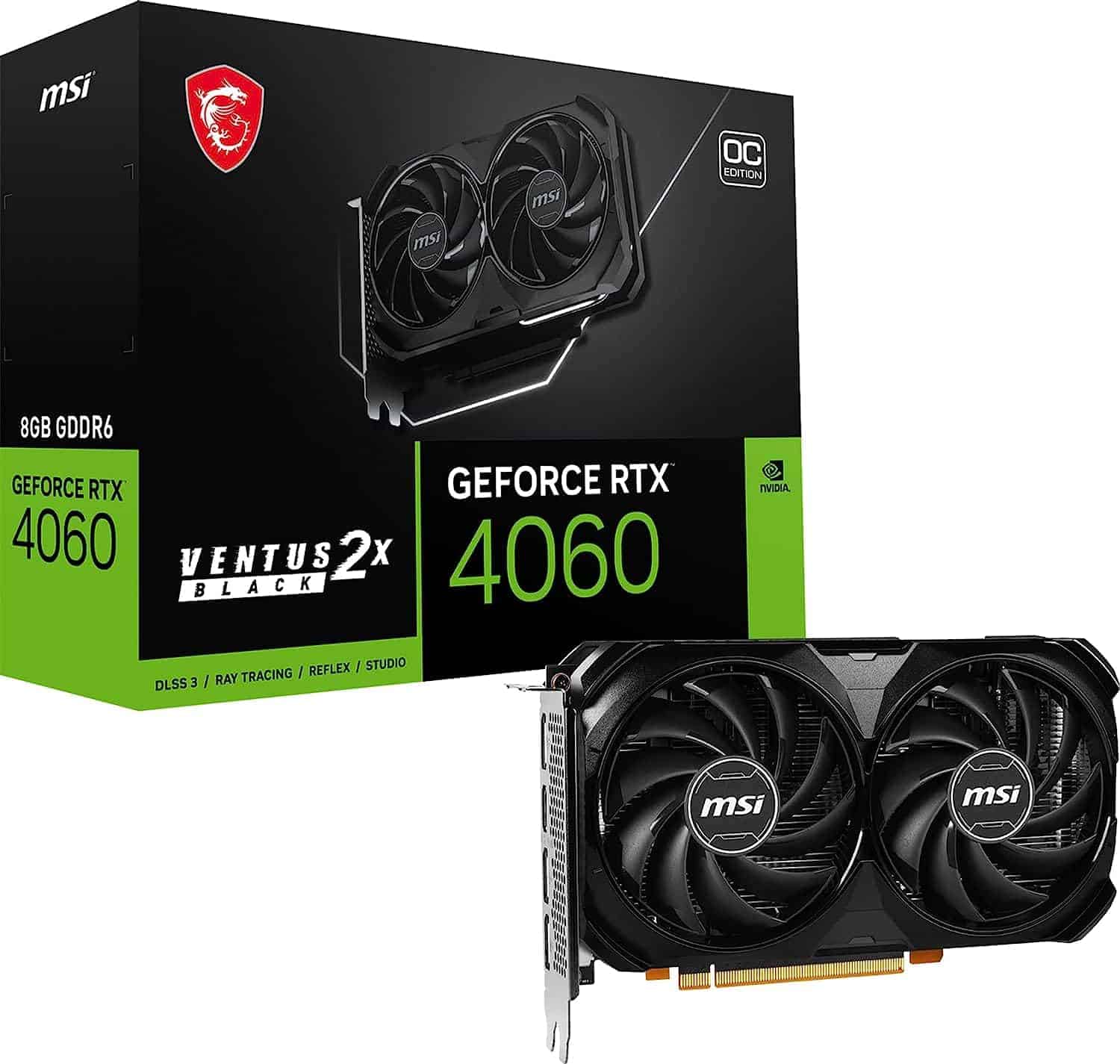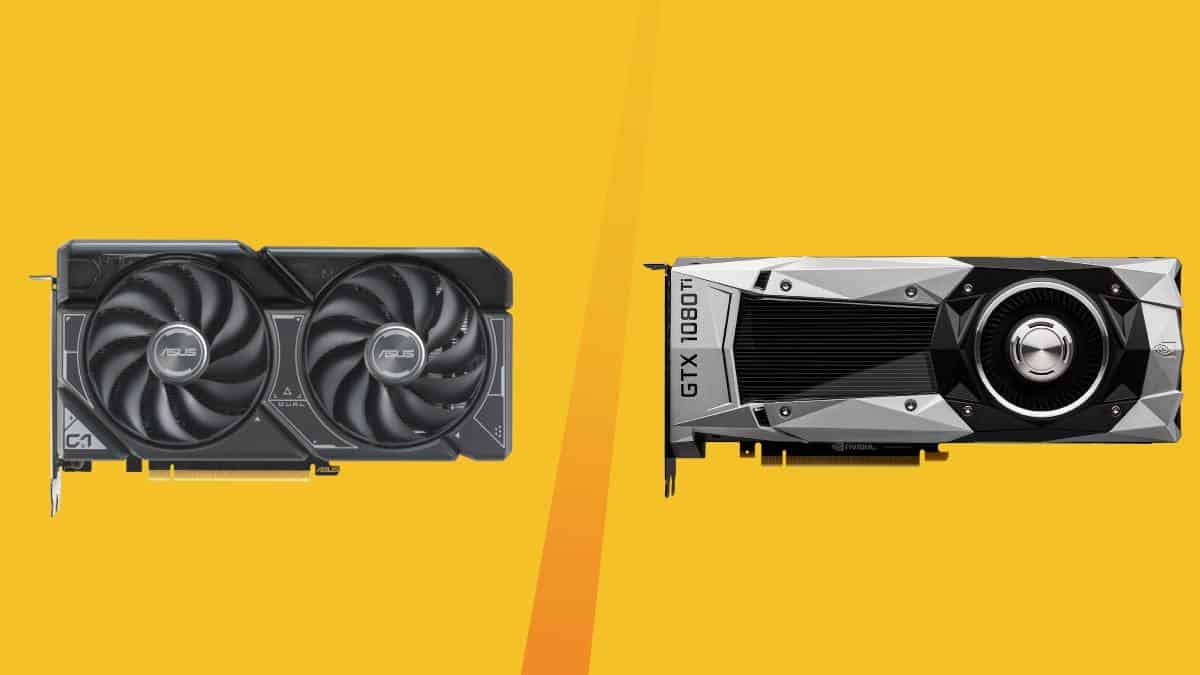You can trust VideoGamer. Our team of gaming experts spend hours testing and reviewing the latest games, to ensure you're reading the most comprehensive guide possible. Rest assured, all imagery and advice is unique and original. Check out how we test and review games here
MSI Gaming GeForce RTX 4060

Base Clock
1830MHz
Boost Clock
2460MHz
VRAM
8GB
Recommended PSU
300W
We’re bringing you our Nvidia RTX 4060 vs GTX 1080 comparison, so you can decide whether now is the time to upgrade your GPU.
The RTX 4060’s release date has arrived. This makes now a great time to start getting a sense of how the card fits into Nvidia’s line-up and whether it could be one you want to buy. For instance, we already know that the card is the cheapest way to get access to DLSS 3 and the Lovelace architecture, until any potential RTX 4050 release date that is.
While the demand for buying the GTX 1080 might not be what it once was, it is still worth considering versus the latest cards on the market. This is because, sooner or later, you’ll want to upgrade to the latest technology, and RTX 4060’s low price point does make it a tempting offer. So is it worth taking the plunge?
To make our comparison as thorough as possible we’ve broken it down into different categories, seeing how the cards shape up in each one of them. Let’s get into it.
RTX 4060 vs GTX 1080 – specs
| RTX 4060 specs | GTX 1080 | |
| Architecture | Ada Lovelace | Pascal |
| CUDA Cores | 3,072 | 2,560 |
| Base Clock (MHz) | 1,830 | 1,607 |
| Boost Clock (MHz) | 2,460 | 1,733 |
| Memory | 8GB GDDR6 | 8GB GDDR5X |
| Memory Bus | 128-bit | 256-bit |
| Memory bandwidth | 272GB/s | 320.3 GB/s |
| Total graphics power | 115W | 180W |
This card shows that the RTX 4060 is the more powerful and capable GPU overall. It is superior in most of the key specs we have listed about. For example, the card has a better clock speed. While for the base clock, the improvement might be marginal, 1830MHz versus 1607MHz, the boost clock sees a more significant difference. The boost clock is a maximum speed that is activated at times of high workload to give you a performance boost.
The RTX 4060 combines this with a higher CUDA core count too. These cores are like the engine room of the GPU and so they have a huge impact on power and speed. In the key spec of memory, both cards do have the same amount overall. However, the RTX 4060’s GDDR6 memory is superior and has higher bandwidth than the GDDR5X of the GTX 1080.
There are three specs where the GTX 1080 boasts the higher number, one of these is total graphics power which is actually a downside and simply reveals that the RTX 4060 is more power efficient. The larger memory bus does facilitate a larger memory bandwidth overall and this has a positive impact on performance. It dictates how fast information can flow between the CUDA cores and VRAM, increasing speed.
RTX 4060 vs GTX 1080 – architecture
Architecture is a vital specs for graphics card performance and here again, the RTX 4060 is ahead. For every new generation of cards, Nvidia releases a new architecture, each one making performance and efficiency improvements over the last. A bit of quick maths can tell you that the RTX 4060 is three generations ahead of the GTX 1080.
This means that while the GTX 1080 has 1st generation Tensor cores, the RTX 4060’s Tensor cores are 4th generation. As a result, they are much more capable in the AI-based operations that this kind of core is designed for. In the RTX 4060, they power DLSS 3, a Lovelace exclusive feature. In compatible games, this can generate frames and upscale performance without requiring more computing power.
Architecture also has a knock-on effect for ray tracing. The RTX 4060 has 3rd generation ray tracing cores, which are very powerful and makes the card one of the best GPUs for ray tracing. There is a common misconception that GTX cards are not capable of ray tracing at all. This is not the case and the GTX 1080 and its Pascal architecture are able to create ray-traced graphics, however, you will see significant drops in performance, sometimes to below playable levels.
RTX 4060 vs GTX 1080 – performance
Now that we have broken down all the specs and features of these cards, let’s have a look at the impact this has on performance.
In normal gameplay with no effects turned on, the performance of these two cards is similar. The GTX 1080 is one of the best GPUs for 1080p, and the same is true of the RTX 4060. This means frame rates fast enough for competitive online play. This is pretty impressive considering how old the GTX 1080 is.
However, there are many scenarios out there where the RTX 4060 performs better. With ray tracing enabled the Lovelace architecture will start to come into its own offering faster frame rates. Similarly, for any game that is compatible with DLSS 3, the RTX 4060 has a significant performance boost, pushing it above the capabilities of the GTX 1080. That said the RTX 4060 is not good for 4K.
RTX 4060 vs GTX 1080 – price
While it may not impact gaming performance, the price can easily be the most important spec of all. On its release day, long ago, the GTX 1080 had an MSRP of $699. Of course, in the 7 years since then, the price did has down. However, it is pretty hard to find the card for brand new in 2023, instead, you can find renewed cards out there for around $400-$500.
The RTX 4060, meanwhile, has an MSRP $299, making it easily one of the best GPUs for under $500. For some this might still be considered expensive, considering the card has just 8GB of VRAM, but you do get access to DLSS 3 and Lovelace for this price. Some AIBs do go for slightly more than this but the vast majority are under $400/ You can find out where to buy the RTX 4060 here.
MSI Gaming GeForce RTX 4060

Base Clock
1830MHz
Boost Clock
2460MHz
VRAM
8GB
Recommended PSU
300W
Final word
There are two main reasons to compare the RTX 4060 vs GTX 1080. The first is because you are wondering which one you should buy and this one has a simple answer. Unless you can find some unholy second-hand deal on a GTX 1080 card, the RTX 4060 makes more sense to go for. With advanced Lovelace architecture, it places you in better stead for future improvements to gaming technology, and DLSS 3 ensures superior performance.
If, however, you already have the GTX 1080 and are wondering whether the RTX 4060 is worth upgrading to, it comes down more to personal preference. The RTX 4060’s price does make it the cheapest card in the RTX 40-series, so if you are budget conscious but want the latest generation it is definitely worth considering. That said, while you will an improvement in overall performance, that improvement will not be huge. If you want to really feel the benefits of upgrading your GPU it could be worth considering the best RTX 4070, or best RX 7900 XTX.







